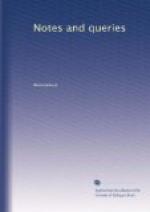If I am not greatly mistaken, your readers will look in vain for a notice of the book in any collected list of the many productions of Abraham Fleming; if I am not greatly mistaken, also, some of them will be disapppointed if I do not subjoin a few sentences describing more particularly the contents of the small volume, which (speaking as a bibliographer) extends to sign. F. iiij in eights.
At the back of the title-page is “The life of Synesius drawen out of Suydas his gatherings,” in Greek and in English. Then comes “The Epistle Apologeticall to the lettered Reader,” signed “Thine for thy pleasure and profite—Abraham Fleming,” which, in excuse for taking up so slight a subject, contains a very singular notice of the celebrated John Heywood, the dramatist of the reign of Henry VIII., and of his remarkable poem The Spider and the Fly. The Pretie Paradoxe, by Synesius, next commences, and extends as far as sign. D. v. b. This portion of the tract is, of course, merely a translation, but it includes a passage or two from Homer, cleverly rendered into English verse. Here we come to the word Finis, and here, I take it, it was originally intended that the tract should end; but as it was thought that it would hardly be of sufficient bulk for the money (4d., or 6d. at the utmost), a sort of appendix was added, which, on some accounts, is the most interesting part of the work.
It is headed “The tale of Hemetes the Heremite, pronounced before the Queene’s Maiestie,” which Warton, who clearly never saw the book, calls the “Fable of Hermes.” In fact, it is, with a few verbal changes, the tale of Hemetes, which George Gascoigne presented, in Latin, Italian, French, and English, to Queen Elizabeth, and of which the MS., with the portraits of the Queen and the author is among the Royal MSS. in the British Museum. Fleming tells us that he had “newly recognised” (whatever may be meant by the words) this tale in Latin and English, but he does not say a syllable whence he procured it. Gascoigne died two years before the date of the publication of this Paradoxe, &c. so that Fleming was quite sure the property could never be challenged by the true owner of it.
Before I conclude, allow me to mention two other pieces by A. Fleming (who became rector of St. Pancras, Soper-lane, in 1593), regarding which I am anxious to obtain information, and seek it through the medium of “NOTES AND QUERIES.”
A marginal note in Fleming’s Translation of Virgil’s Georgics, 1589, 4to., is the following:—“The poet alludeth to the historie of Leander and Hero, written by Museus, and Englished by me a dozen yeares ago, and in print.” My question is, whether such a production is in existence?




